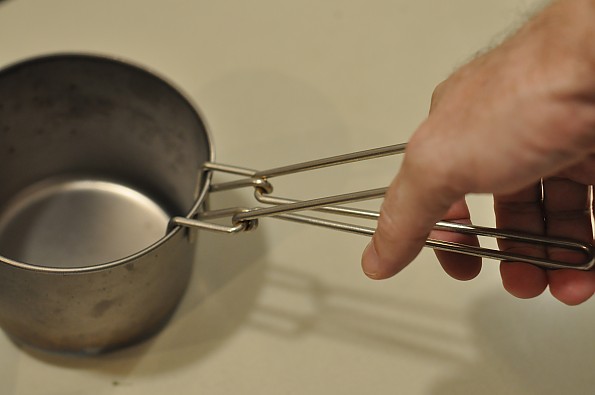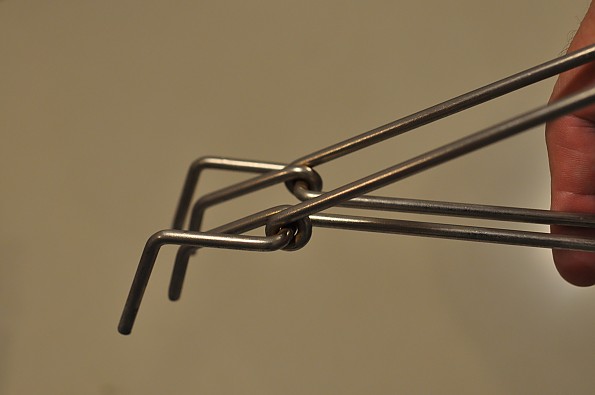Paddy Pallin Spondonicles

“Spondonicles” (also known as billy lifters, pot lifters, or pan grips) were made by Paddy Pallin in Australia up until about 1980. Unfortunately they are no longer made and impossible to get. Uniquely Australian, they have been widely copied, but nothing performs as well as the original. They are now collector's items!
Pros
- Long handles
- Can lift any billy or pot
Cons
- No longer available
Heresay has it that the "spondonacle" or "billy lifter" or "pot lifter" was designed by early bushwalkers in NSW Australia in the 1950s. They certainly appear to have been invented in Australia. The famous Australian bushwalker Paddy Pallin sold them commercially until the late 1970s in his chain of stores.
For a while in the 1980's they were often referred to as "Paddy's fingers". Virtually every Australian bushwalker of that era used to have a "pair". They were always referred to as a pair, similar to a pair of scissors. But unfortunately for Paddy Pallin he did not patent the concept, so they became widely copied.
There are now at least 10 similar products (listed from lightest to heaviest)
- 23g Vargo Titanium Pot Lifter
- 28g MSR LiteLifter
- 43g Olicamp Pot Lifter
- 48g Trangia Pan Grip (and also the discontinued Pot Gripper)
- 54g Optimus Terra Pot Lifter
- 56g MSR PanHandler
- 57g Open Country Aluminum Pot Lifter (available through REI)
- 60g REI Campware Pot Lifter (no longer available)
- 71g GSI Outdoors DiamondBack Gripper / Pot Lifter (available through REI)
- SIGG make one as well, but I cannot find specifications
Trangia is the only company that has tried to use the same name. This is speculation, but there may have been a cease and desist letter that stopped them.
The original and the arguably the best, the Paddy Pallin "Spondonacles" weighed a "massive" 100g. Undeniably the new ones are light, but the problem is that all of the modern ones are too short, but more of that later.
In Australia, irrespective of brand, they are almost universally called "spondonacles". The origin of the word is uncertain. There are a couple of theories. Some say that the word "spondonacle" is derived from the Latin word spondali, meaning "strong finger". An academically credible etymology.
But the most likely source (per David Noble, a famous Australian bushwalker / outdoors blogger) is that the name came from a Three Stooges movie where they are performing a surgical operation. Larry (the guy with the straight hair) is the surgeon and the other two are helpers.
Larry: “anaesthetic”
Helper passes large rubber mallet, Larry dongs patient on head.
Larry: “scalpel”
Helper (passes scalpel): “scalpel”
Larry: “scissors”
Helper (passes scissors): “scissors”
Larry: “spondonical”
Helpers: "spondonical?!” (rummage frantically through piles of instruments)
What is it that was so good about the originals and why have they never been copied? The actual method of manufacture does not appear complex.
The same David Noble wrote that:
"I can remember talking to Nick Gooch, when he was manager of Paddy Pallins Sydney Store back around 1980 about them. This was just after they were no longer being made. He explained that they were a special order for Paddy Pallins, made by a fellow who had a machine that could bend strong wire and its usual use was for making rabbit traps. The reason they were no longer being made was that the fellow had retired and the machine was no longer running."
My original “spondonicles” (billy lifters) were bought in a Paddy Pallin shop circa 1978 and are still going strong but they are now unfortunately impossible to get. In Australia we usually cook on campfires and David and I have both observed that everyone is envious when we pull out an old pair of spondonacles to lift billies on and off the fire. They are incredibly durable. You can see from the photos that mine look almost new 38 years later.
Why? What is it about the old “spondonicles” that work so well. One factor is that the wood calorific value of timber is largely constant by weight but the radiant heat from a fire varies immensely. A campfire from Australian Hardwood has significantly greater radiant heat than just about any other timber. Radiant heat from an Australian bushfire can exceed 100 kW/m2 by a considerable margin. This is largely a function of the effective flame temperature.
And that is what is so wrong with all the modern spondonicals! Sure they are lighter (being made from ABS plastic, aluminium or titanium) and fine for lifting pots off gas stoves, but not so good when it comes to campfires. The handles are simply not long enough!
Australia is a relatively small market. There are only 25 million of us and even less bushwalkers. We need “spondonicles” with longer handles because our campfires are almost an order of magnitude hotter than the campfires of most other countries. Ask any Australian hiker and they will tell you that all the modern ones don't really work.
But there may be good news for all Australian Bushwalkers. There is a guy in Australia who is proposing to tool up for another production run, he has an online survey where you can submit your name and details. But this has been running for a while and he has not got anywhere yet. We live in hope that he or maybe another manufacturer will rise to the challenge.
Hopefully this problem will be solved in my lifetime!
Source: bought it new
Price Paid: AUD $20
They truly were a most versatile piece of kit.
Pros
- Length—to keep hands away from flames
- Multiple use modes
Cons
- Length
- Weight
- Awkward shape to fit in a pack
- Potential rubbing from 'points' can wear through pack
I second the version name of 'Chinese hoodlum gangs'. It may be apocryphal, but my late father, former tiger-walker and CMW member, Brian Douglas Walker, claimed he'd been calling them that since they were first made. But as he didn't start bushwalking until the early Fifties, I do not know when Paddy first had them made.
I certainly have a pair that belonged to my dad and would date from the Sixties at the very least.
They are especially useful as others have pointed out for being able to get away form the heat of the fire due to their length, but they are also equally good when flipped and used as a straight lifter, using the V made by the inverted tongs to hook under the wire handles of the various pts and billies (known as William Canisters in our family).
Another little known benefit is the ability to bend the inner wire open slightly so that, reversed (V-upwards) the inner wire can be slid under the old-atyle billy lids 'button-shaped knobs, and successfully and safely removed.
They truly were a most versatile piece of kit.
Source: received it as a personal gift
Growing up in Sydney we called these "Chinese hoodlum gangs," or "gangs" for short. In ancient China secret criminal societies were called Tongs. With the advent of the Maoist regime, it was said the Tongs had become Chinese hoodlum gangs.
They are brilliant tools. I wish I hadn't got rid of mine years ago in a cleanup. Nothing else is long enough.
Pros
- Light
- Simple
- Sturdy
- Multi-purpose
- LONG
Cons
- No longer available
- Someone with high-tensile rod manufacturing equipment, please tool up and make these again
I've just reviewed my new tongs, over at https://www.trailspace.com/gear/rome-industries/49-campfire-gripper-stainless-steel/#review40310
Background
See the review linked above
Source: bought it new
Price Paid: AUD42.30 including postage
Yep, Dave Noble is correct about the name Spondonicles. However the timing is somewhat earlier than 1978. I bought mine in the earlier 1970s from Paddy Pallin, while in the Mt Druitt Bushwalking Club. Any self-respecting true bushwalker wouldn't be seen without his/her Sponds. An essential piece of kit.
Pros
- Essential
Cons
- None
Background
Can't do a bushwalk without them
Source: bought it new
Price Paid: 5




